Artillery in Canada (4) Manitoba: CFB Shilo, Royal Regiment of Canadian Artillery Museum (1)

(York Sunbury Historical Society, Fredericton Region Museum Collection, Author Photo)
1997.28.42. RCA badge, QC.
Artillery in Manitoba, CFB Shilo,
Royal Canadian Artillery Museum
The aim of this website is to locate, identify and document every historical piece of artillery preserved in Canada. Many contributors have assisted in the hunt for these guns to provide and update the data found on these web pages. Photos are by the author unless otherwise credited. Any errors found here are by the author, and any additions, corrections or amendments to this list of Guns and Artillery in Canada would be most welcome and may be e-mailed to the author at [email protected].
For all official data concerning the Royal Regiment of Canadian Artillery, please click on the link to their website:
Royal Regiment of Canadian Artillery Website
Note: Back in the day, artillery in Canada was referred to by its radio call sign "Sheldrake". It is now referred to by its "Golf" call sign. (Acorn sends)
Guns and Cannon
Those of us with an interest in old guns and cannon generally have to sort them out by size and purpose. If the weapon can be transported by manpower alone, and if it relies on direct hits to kill, then it is classed as a gun. If it takes more than one gunner to operate and is too heavy to be transported by manpower alone, and if its main purpose is to kill via shrapnel or concussion or to destroy obstacles, then it is a cannon. Even when they are not in action against a target that can shoot back, they can be extremely dangerous, particularly when at sea.

CFB Shilo, Royal Canadian Artillery Museum



(Clive Prothero-Brooks Photo)
Bronze3-pounder 3-cwt Smoothbore Muzzleloading Gun, weight 2-2-27 (307 lbs) (J. &H. King, 1810) and CCCCXLV (445) on the chase, blank on the left trunnion, (Serial No. 445) on right trunnion, General John Pitt, 2nd Earl of Chatham, Master General of the Ordnance 1801–1806 and 1807–1810, cypher on the barrel, above the King George III cypher, mounted on a wood Naval Gun carriage. This gun was with the Hudson’s Bay Company. No. 1 of 2.
The Master General of the Ordnance was a very senior British military position from 1415 to 2013 (except 1855-1895 and 1939-1958) with some changes to thename, usually held by a serving general. The Master-General of the Ordnance was responsible for all British artillery, engineers, fortifications, military supplies, transport, field hospitals and much else, and was not subordinate to the commander-in-chief of the British military.

Cypher, General John Pitt, 2nd Earl of Chatham, Master General of the Ordnance 1801–1806 and 1807–1810.


King George III and his cypher.



(Clive Prothero-Brooks Photos)
Bronze 3-pounder 2-cwt Smoothbore Muzzleloading Gun, weight 2-0-14 (238 lbs), (F. Kinman, 1812) on the chase (Francis Kinman at Woolwich, England), (Serial No. 447) on right trunnion, 3-inch bore, length 36 inches, mounted on a wood Naval Gun carriage. Hudson’s Bay Company gun with spiked vent. No. 2 of 2.

Vector representation of an Model 1805 Carronade: 1. Breech bolt, 2. Aft sight, 3. Vent hole, 4. Front sight, 5. First reinforcing ring, 6. Barrel ,7. Muzzle, 8. Second reinforcing ring, 9. Azimutal pivot, 10. Chock, 11. Elevation pivot, 12. Wheel, 13. Mobile pedestal, 14. Carriage, 15. Pommel, 16. Elevation thread. Delaby Pierre (Walké)
18-pounder 10-cwt Smoothbore Muzzleloading Carronade. The carronade is a short smoothbore, cast iron cannon, which was used by the Royal Navy and first produced by the Carron Company, an ironworks in Falkirk, Scotland. It was used from the 1770s to the 1850s. Its main function was to serve as a powerful, short-range anti-ship and anti-crew weapon. While considered very successful early on, carronades eventually disappeared as rifled naval artillery changed the shape of the shell and led to fewer and fewer close-range engagements.

(Library and Archives Canada Photo, MIKAN No. 3394435)
Nordenfelt 6-pounder QF Gun mounted on a wheeled carriage. This type of gun was also used in the coastal defence role. Photo c1900.


(Maxwell J. Toms Photos)
Bronze 9-pounder 13-1/2-cwt Smoothbore Muzzleloading Gun, weight 1,512 lbs (687 kgs), maker and Serial No. TBC, mounted on a wheeled wood gun carriage.

(Maxwell J. Toms Photo)

(Author Photo)

(Clive Prothero-Brooks Photos)

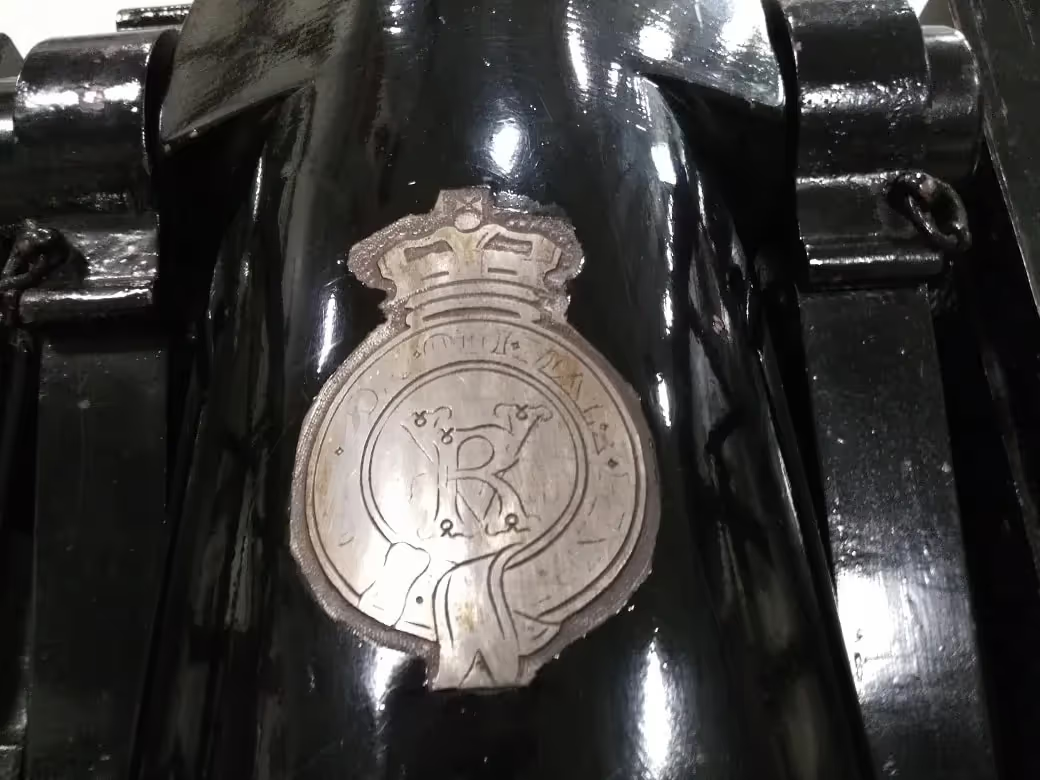



(Leon Jenson Photos)
9-pounder 6-cwt Land Service (L.S.) Muzzleloading Rifle, weight 5-3-27 (671 lbs), (RGF No. 450, Mk. II, 1876) on left trunnion, Firth Steel No. 4539 on the muzzle, Queen Victoria cypher, broad arrow mark, mounted on an iron carriage with wood wheels. This gun was a new design in 1874 for the Royal Horse Artillery. It was longer than the 8-cwt gun but had the same carriage. It is on a five year loan to the 15th Field Artillery Regiment Museum & Archives in Vancouver from the RCA Museum.

(Library and Archives Canada Photo, MIKAN No. 3300651)
9-pounder 8-cwt Guns, 13th Battery, Winnipeg, July 1905.
A 9-pounder 6-cwt (SS) Muzzleloading Rifle, weight 5-3-26 (670 lbs), (RGF No. 399, II, 1875) on the left trunnion, blank on the right trunnion, Firths Steel 4320 on the muzzle, Queen Victoria cypher on the barrel, is preserved in Halifax, Nova Scotia. The gun is mounted on an iron carriage, WD, RCD 11872, No. 60, I, with wood 12-pounder wheels, ca. 1874-1895, and stands facing the Halifax Citadel. A third 9-pounder 6-cwt Muzzleloading Rifle is on display at the war memorial in Shelburne, Nova Scotia, RGF No. unknown. These 9-pounder 6-cwt guns were probably left behind when the British left Halifax in 1905. All other 9-pounder Muzzleloading Rifles in Canada are 8-cwt.

(Clive Prothero-Brooks Photo)
9-pounder 8-cwt Muzzleloading Rifle with Limber, weight 8-1-6 (930 lbs), (RGF No. 620) on the left trunnion, Queen Victoria cypher, broad arrow mark, Serial No. 5791 on the muzzle, mounted on a wood wheeled field carriage, Serial No. 1460, This gun is on loan from RCMP Depot, and is on display inside the 1 RCHA HQ, 2nd floor. 1 RCHA.


(Clive Prothero-Brooks Photos)


(Maxwell J. Toms Photos)
12-pounder 6-cwt Breechloading Mk. I Gun (Serial No. 111), mounted on a Mk. I Field Carriage.

(Maxwell J. Toms Photo)
15-pounder 7-cwt Breechloading Mk. I Gun mounted on a Mk. I Field Carriage.

(Library and Archives Canada Photo, MIKAN No. 3404495)
1-pounder QF Mk. I (Maxim) Gun, V.S.M. (Vickers, Sons & Maxim Limited) 1904, Automatic Guns, Captain Wheatley and Sub Staff of Machine Gun School, M.D. 10, Winnipeg, Manitoba, 16 Dec 1916.




(Clive Prothero-Brooks Photos)
1-pounder QF Mk. I (Maxim) Gun, V.S.M. (Vickers, Sons & Maxim Limited) 1904, Automatic Gun, (Serial No. 2513), weight 410 lbs, mounted on a VSM London gun carriage, (Serial No. 5700). Base HQ.




(Clive Prothero-Brooks Photos)
1-pounder QF Mk. I (Maxim) Gun, V.S.M. (Vickers, Sons & Maxim Limited) 1905, Automatic Gun, (Serial No. 2497), weight 410 lbs, Reg. No. 117, mounted on a 1-pounder QF Mk. II gun carriage, RCD, 1906, Reg No. C10444. This "pom-pom" gun stands inside the main entrance to the Base HQ.

(Clive Prothero-Brooks Photo)

(Maxwell J. Toms Photo)
Armstrong 40-pounder 35-cwt Rifled Breech-loading Gun, 1867, CFB Shilo Gym. This gun with a 4.75 inch calibre, was a naval and fortification gun in use from 1860 to the early 1900s. The guns were typically employed mounted on high "siege travelling carriages" for use as semi-mobile guns in forts, firing over parapets. Many were mounted on travelling carriages and used by many Volunteer Artillery Batteries to whom they were issued after 1889. Most remained in use in this role until 1902. A number were used for some years afterwards as saluting guns. One other Armstrong 40-pounder 35-cwt Rifled Breech-loading Gun is on display in the Canadian War Museum, Ottawa, Ontario.

(Library and Archives Canada Photo, MIKAN No. 3405480)
4.7-inch QF Mk. IV* "B" Gun on Mk. I Travelling Carriage, Canadian Artillery, 1915.

(Library and Archives Canada Photo, MIKAN No. 3405481)
4.7-inch QF Mk. IV* "B" Gun on Mk. I Travelling Carriage, Canadian Artillery, 1915.


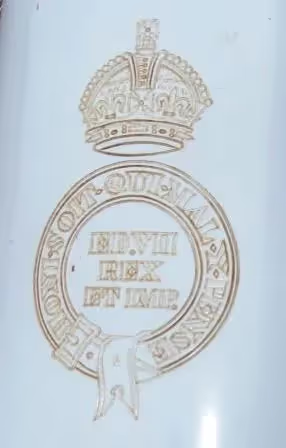
(Canadian Copyright Collection Photo, held by the British Library)
King Edward VII and his cypher, (Albert Edward, 9 November 1841 – 6 May 1910).



(Maxwell J. Toms Photos)




(Clive Prothero-Brooks Photos)
4.7-inch QF Mk. IV* "B" Gun on Mk. I Travelling Carriage, Shilo Golf Course. The BL 4.7 inch 45 calibres gun (actually a metric 120-mm gun) was a British medium-velocity naval gun introduced in 1918 for destroyers, intended to counter a new generation of heavily armed destroyers that Germany was believed to be developing.

(Library and Archives Canada Photo, MIKAN No. 3404393)
Canadians training on heavy guns, Whitley Camp, England, 1917.

(Library and Archives Canada Photo, MIKAN No. 3395600)
Canadian Artillery Observation Post inreserve line, Jan 1918.

(Library and Archives Canada Photo, MIKAN No. 3395561)
Observation and Advanced Listening Post, Sep 1916.

(Library and Archives Canada Photo, MIKAN No. 3404935)
Canadian Artillery passing an Observation Balloon which is being brought down. Advance East of Arras. September, 1918.





(Maxwell J. Toms Photos)

(Clive Prothero-Brooks Photo)
8-inch BL Mk. IV Howitzer, Sergeant’s Mess.

(Library and Archives Canada Photo, MIKAN No. 3395356)
Canadian 8-inch BL Mk. VI Heavy Howitzer arriving at a Canadian Mobile Ordnance Workshop. February, 1918.

(Library and Archives Canada Photo, MIKAN No. 3395380).
8-inch Breechloading Mk. VI Howitzer M1917, on Mk. VIIA Carriage July 1918.

(Library and Archives Canada Photo, MIKAN No. 3395340)
8-inch Breechloading Mk. VI Howitzer M1917, Jan 1918.

(Library and Archives Canada Photo, MIKAN No. 3517340).
8-inch Breechloading Mk. VI Howitzer M1917 being hauled into position, June 1917.

(Library and Archives Canada Photo, MIKAN No. 3395309), and
8-inch Breechloading Mk. VI Howitzer M1917 at full recoil, Oct 1917.


(Maxwell J. Toms Photos)

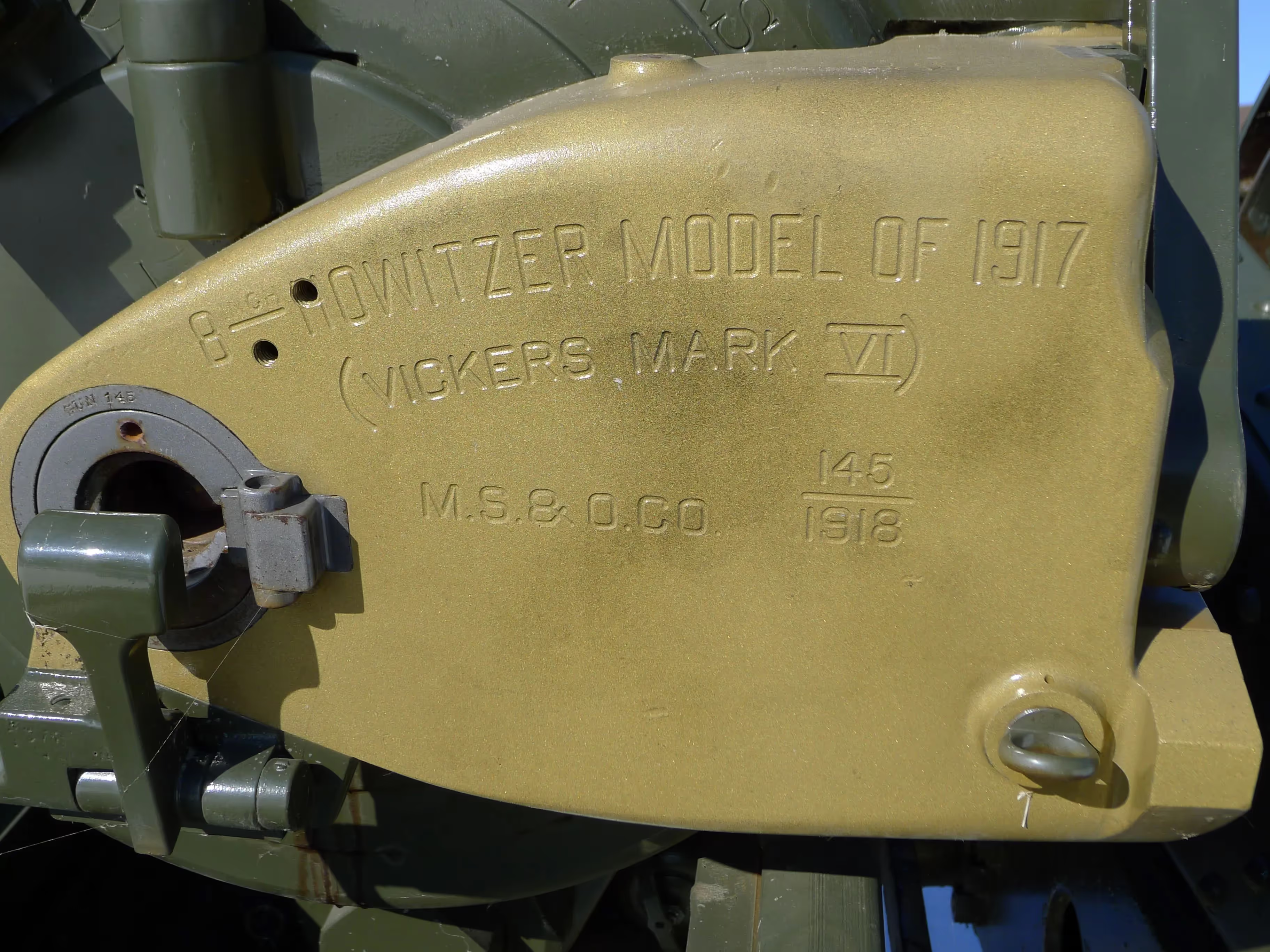


(Clive Prothero-Brooks Photos)
8-inch Breechloading Mk. VI Howitzer M1917, on Mk. VIIA Carriage No. 201. Officer's Mess.

(Library and Archives Canada Photo, MIKAN No. 2837452)
QF 4.5-inch Mk. II Howitzer on Mk. I Carriage. Gunners in action during the Battle of Vimy Ridge, painting by Richard Jack.

(Library and Archives Canada Photo, MIKAN No. 3522153)
QF 4.5-inch Mk. II Howitzer on Mk. I Carriage, with Officers of the 48th Bty, CFA, June 1918.



(Clive Prothero-Brooks Photos)
QF 4.5-inch Mk. II Howitzer on Mk. I Carriage. This is the only one remaining in Canada. Except for 12 Mk. I versions, all Canadian 4.5-inch howitzers were Mk. II. All the carriages for these howitzers were made by the Ottawa Car Manufacturing Company (OCM) except for possibly four or so before the First World War. (Doug Knight)

(Library and Archives Canada Photo, MIKAN No. 3404392)
Canadian Artillerymen training on a 6-inch 26-cwt Breechloading Mk. I Howitzer on a Mk. I Travelling Carriage at Whitley Camp, England, 1917.
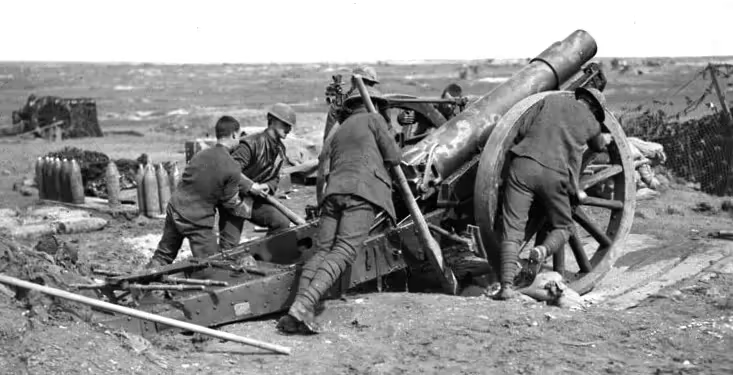
(Library and Archives Canada Photo, MIKAN No. 3395353)
6-inch 26-cwt Breechloading Mk. I Howitzer on a Mk. I Travelling Carriage, Canadian Artillerymen Feb 1917.

(Library and Archives Canada Photo, MIKAN No. 360756)
6-inch 26-cwt Breechloading Mk. I Howitzer with pneumatic tires in the Second World War.




(Clive Prothero-Brooks Photos)
6-inch 26-cwt Breechloading Mk. I Howitzer manufactured at W.B & Co No 5281 in 1918. It is mounted on carriage No. CA920. This gun is one of two in Canada, the other is with 3 Field Regiment in Saint John, New Brunswick.

(Library and Archives Canada Photo, MIKAN No. 3522237).
60-pounder Breechloading Mk. I Howitzers in action, Battle of Amiens, France, August 1918.

(Library and Archives Canada Photo, MIKAN No. 3336979)
60-pounder Breechloading Mk. I Gun, Camp Valcartier, Quebec, ca. 1914.

(Library and Archives Canada Photo, MIKAN No. 3336982),
60-pounder Breechloading Mk. I Gun, Camp Valcartier, Quebec ca. 1914.


(Library and Archives Canada Photo, MIKAN No. 3337050)
60-pounder Breechloading Mk. I Gun, Camp Valcartier, Quebec, ca. 1914.

(Library and Archives Canada Photo, MIKAN No. 3522237)
BL 60-pounder field guns in action. Battle of Amiens. August 1918.



(Clive Prothero-Brooks Photos)
60-pounder Breechloading Mk. I Gun, inside the museum.

(Library and Archives Canada Photo, MIKAN No. 3395180)
9.2-inch Breechloading Mk. I Howitzer on a Mk. I Carriage being loaded, Sep 1916. The shell weighed 290 lbs (130 kgs). The steel box the howitzer rests on was filled with about 9 tons of earth to stabilize the mounting can be seen behind the gunner holding the hand wheel on the right. Two Canadian batteries used these guns in France.
* For more detailed data on the 9.2-inch BL Howitzer Doug Knight's book can be reviewed free on the net here: https://archive.org/details/the-9.2-inch-coast-defence-gun-in-canadian-service.

(Library and Archives Canada Photo, MIKAN No. 3194249)
9.2-inch Howitzer, Canadian Gunners, Sep 1917.

(Library and Archives Canada Photo, MIKAN No. 3395220)
9.2-inch Heavy Howitzer on the Somme, Nov 1916.

(Library and Archives Canada Photo, MIKAN No. 3395221)
9.2-inch Heavy Howitzer on the Somme, Nov 1916.

(IWM Photo, H1468)

(Martin Wickary Photo)
9.2-inch Breechloading Mk. I Howitzer on a Mk. I Carriage. The photo on the left shows Gunners of the British 56th Heavy Regiment with a Mk. II Howitzer, May 1940, the photo on the right shows a Mk. I preserved in the Imperial War Museum. The 1st Siege Battery in the 1st Brigade, Canadian Garrison Artillery, and the 5th Siege Battery in the 2nd Brigade, CGA, used the 9.2-inch howitzer. Both brigades were part of the Canadian Corps Artillery. This was the heaviest howitzer used by the RCA during the First World War. None are preserved in Canada.
During the Second World War, the 57th (Newfoundland) Heavy Regiment, Royal Artillery, was equipped with 9.2-inch howitzers when it was formed in 1940. They gave them up when they were converted to a field regiment on 15 Nov 1941. The 59th (Newfoundland) Heavy Regiment was also issued 9.2-inch howitzers (and other types) in July 1940. They continued to use them until they were replaced by 7.2-inch howitzers in September 1942. (Doug Knight)

(Library and Archives Canada Photo, MIKAN No. 3205394)
7.2-inch howitzer being fired on German positions, 28 June 1944.

(Library and Archives Canada Photo, MIKAN No. 3522407)
12-inch Naval Howitzer, mounted on a railway platform, Nov 1917.

(Library and Archives Canada Photo, MIKAN No. 3522406)
12-inch Naval Howitzer in action, Vimy Ridge. November, 1917.

(Library and Archives Canada Photo, MIKAN No. 3194250)
15-inch gun base being rivetted, Oct 1917.

(Library and Archives Canada Photo, MIKAN No. 3395166)
15-inch heavy howitzer being loaded, Sep 1916.

(Library and Archives Canada Photo, MIKAN No. 3395235)
15-inch Howitzer Breech, May 1917.

(Library and Archives Canada Photo, MIKAN No. 3395237)
15-inch gun being cleaned, May 1917.

(Library and Archives Canada Photo, MIKAN No. 3395239)
15-inch gun being cleaned, May 1917.

(Library and Archives Canada Photo, MIKAN No. 3194244)
15-inch gun, May 1917.

(IWM Photo Q4459)
15-inch Breechloading Howitzer, on the Western front, May 1917. Although data for the photograph on the left indicates these are Canadian soldiers examining the howitzer, they were not used by Canadian gunners, and none are preserved in Canada.





(Clive Prothero-Brooks Photos)
13-pounder 6-cwt QF Mk. I Field Gun, weight 6-0-13 (685-lbs), RGF J 1913, N. 290 on barrel, carriage plate 13-pr Mk. I.IP, L, 1917, GCR 1910, Reg. No. 10.

(Library and Archives Canada Photo, MIKAN No. 3563835)
18-pounder QF Mk. I Field Gun being examined by the Earl of Athlone, Governor General of Canada, during his visit to the 4th Fd Regt, RCA, Petawawa, Ontario, 1940.

(Leon Jensen Photo)

(Maxwell J. Toms Photo)



(Terry W. Honour Photos)
18-pounder QF Mk. II VSM Field Gun with pneumatic tires, VSN 1918, Serial No. 8864.


(Clive Prothero-Brooks Photos)
18-pounder QF Mk. I Field Gun with spoked carriage wheels.

(Library and Archives Canada Photo, MIKAN No. 3336980)
18-pounder QF Mk. I Field Gun, Camp Valcartier, ca. 1914.

(Library & Archives Canada Photo, MIKAN 3405482)
18-pounder QF Mk. I Field Gun, RCA, ca. 1918.

(Library and Archives Canada Photo, MIKAN No. 3642847)
18-pounder QF Mk. I Field Guns, Sir Robert Borden, Bramshot, UK, Apr 1917.

(Library and Archives Canada Photo, MIKAN No. 3224682)
75-mm Field Gun mounted front and rear on a Canadian National Railway Armoured train, often traveling through Winnipeg during the Second World War, 15 July 1942.


(Maxwell J. Toms Photos)
U.S. Model 1917A1 (M1971A1) 75-mm field gun (British), Bethlehem Steel Co., 1912, 995 Pounds, (Serial No. TBC) on the muzzle. This gun is mounted on a 75-mm Gun Carriage Model of 1917 (British), Bethlehem Steel Co., 1918, (Serial No. TBC), MMC, according to the builder's plate on the carriage. This gun has been "high-speeded" with Martin Parry gear. It is an American version of the British QF 18-pounder modified to fire French 75-mm ammunition. A similar M1971 field gun is preserved in the Royal Regiment of Canadian Artillery School, 5 Canadian Division Support Group Base Gagetown, New Brunswick.
Although most field artillery enthusiasts note the d muzzle (flush with the front of the recoil guides) of the American piece vis-à-vis its British counterpart, many miss the difference in the configuration of the splinter shield. The main shield (ignoring the top and bottom extensions) of the British gun (both 18-pounder and 13-pounder) is bent back at the level of the gun, whereas the main shield of the American gun is not, but is straight up and down (though tilted back a little from bottom to top). An American business firm or the American military unit whose size lies between the platoon and the battalion is ALWAYS abbreviated “Co.” NEVER “Coy.” The latter is for British and Commonwealth usage. (Nelson Lowry)

(Library & Archives Canada Photo, MIKAN No. 3223277).
40-mm Bofors Light Anti-Aircraft Gun, manned by Canadian Gunners, Brighton, England, March 1943.


(Clive Prothero-Brooks Photos)
40-mm Bofors Light Anti-Aircraft Gun.

(Library and Archives Canada Photo, MIKAN No. 4233812)
40-mm Bofors Light Anti-Aircraft Gunners in Normandy.









(Maxwell J. Toms Photos)

(Clive Prothero-Brooks Photo)
40-mm Bofors Light Anti-Aircraft Gun Mk 1 (naval mount), CFR 34522, Officers’ Mess.


40-mm Bofors Light Anti-Aircraft Gun Mk. III, O.F.E./C 1942, Reg. No. L/12971 (Bantam).

(Library and Archives Canada Photo, MIKAN No. 3607529)
3.7-inch Heavy Anti-Aircraft Gun manned by 2nd Canadian Heavy Anti-Aircraft Regiment.

(Library and Archives Canada Photo, MIKAN No. 3225276)
3.7-inch Heavy Anti-Aircraft Gun being cleaned.

(Library and Archives Canada Photo, MIKAN No. 3211345)
3.7-inch Heavy Anti-Aircraft Gun, 2nd Heavy Anti-Aircraft Regiment, RCA.

(Library and Archives Canada Photo, MIKAN No. 4233362)
3.7-inch Heavy Anti-Aircraft Gun being maneuvered out of the mud.

(Library and Archives Canada Photo, MIKAN No. 4233960)
3.7-inch Heavy Anti-Aircraft Gun Battery, Artillery ranging equipment, 1st Canadian Division, England, ca 1942.

(Library and Archives Canada Photo, MIKAN No. 4234049)
3.7-inch Heavy Anti-Aircraft Gun.


(Clive Prothero-Brooks Photos)
3.7-inch Anti-Aircraft Gun, No. 1 of 2.

(Maxwell J. Toms Photo)
3.7-inch Anti-Aircraft Gun, mounted on wheels, No. 2 of 2.

(Library and Archives Canada Photo, MIKAN No. 3196436)
3.7 Anti-Aircraft gun being fired at Valcartier, Quebec, Feb 1943.

(Library and Archives Canada Photos, MIKAN No. 3196437)
3.7 Anti-Aircraft gun being fired at Valcartier, Quebec, Feb 1943.

(Library and Archives Canada Photo, MIKAN No. 3196440)
3.7 Anti-Aircraft gun being fired at Valcartier, Quebec, Feb 1943.
American 90-mm M1A1 Anti-Aircraft Gun.





(Clive Prothero-Brooks Photo)
Sherman Skink 20-mm Quad Self-Propelled Anti-Aircraft Gun Turret.


(Author Photos)


(Clive Prothero-Brooks Photos)
Oerlikon 35-mm twin cannon towed anti-aircraft gun paired with the off-gun Skyguard fire control radar system.



(Author Photos)


(Clive Prothero-Brooks Photos)
Skyguard fire control radar system for the Oerlikon 35-mm twin cannon towed anti-aircraft gun.

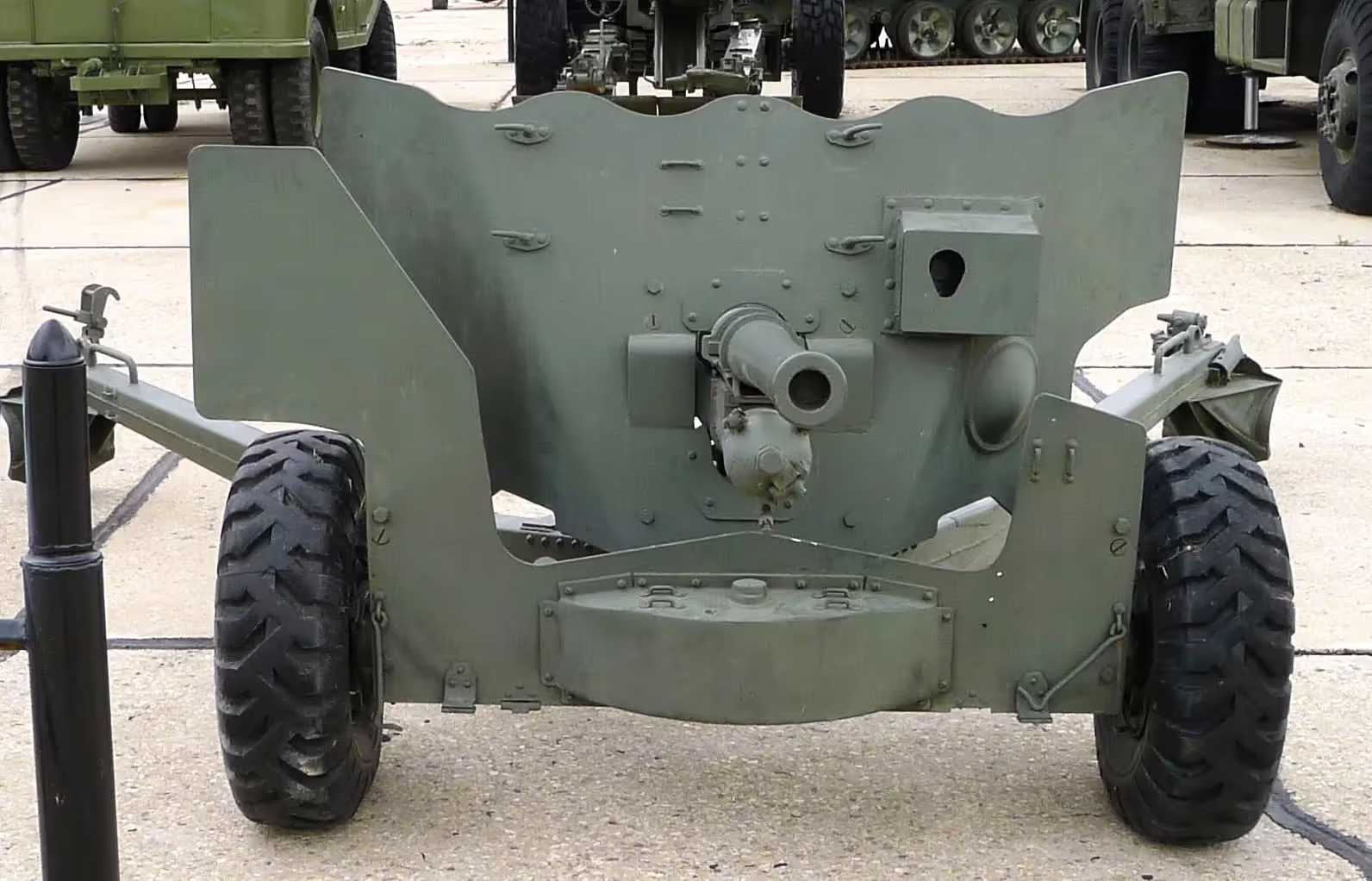

(Clive Prothero-Brooks Photo)
2-pounder QF Mk. X Anti-Tank Gun.






(Rob Love Photos)
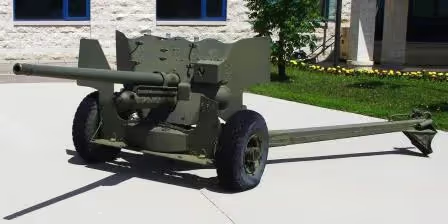
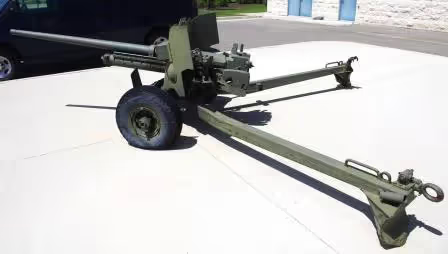


(Maxwell J. Toms Photos)
QF 2-pounder David experimental Anti-Tank gun developed in Canada during the Second World War and recently rediscovered in Shilo. It is a hybrid that used a 6-pounder necked down to a 2-pounder shot.

(Library and Archives Canada Photo, MIKAN No. 3524442)
6-pounder 7-cwt QF Anti-Tank Gun crewed by Private L.P. McDonald and Lance-Corporals W. Stevens and R. Dais, all of the Royal Canadian Artillery at Nieuport, Belgium, 9 September 1944.


(Clive Prothero-Brooks Photos)
6-pounder 7-cwt QF Anti-Tank Gun (Serial No. 206).

(Maxwell J. Toms Photo)

(Clive Prothero-Brooks Photo)
17-pounder QF Towed Anti-Tank Gun, CFB Shilo Gym.
In June 1947, Canada had 149 17-pounder QF Towed Anti-Tank Guns in service. These guns served until 1952, when they were offered to NATO. Those remaining in 1959 were scrapped or became part of war memorials including at least 28 have been found and documented on these web pages.

95-mm Centaur IV tank, 11th Armd Div, Travemunde, Germany, 3 May 1945. (IWM Photo BU 5278)

95-mm Centaur IV tank, Royal Marine Armoured Support Group, 13 June 1944. (IWM Photo B 5457)

(D Sean Barnett Photo)
95-mm Centaur Tank Howitzer provided close support to infantry by laying smoke screens or engaging pillboxes. During the Second World War the First Canadian Army used British Centaurs manned by Canadian gunners. The 1st Centaur Battery, RCA, was formed on 6 August 1944 and was comprised of an HQ and three troops, each equipped with one Sherman OP tank and four 95-mm SP Centaurs. Their main role included carrying out harassing fire on the enemy's logistic elements and retaliatory fire on mortars and support weapons. The battery fought in a number of engagements in Normandy until it was disbanded on 29 Aug 1944. One Centaur has been preserved at Sword Beach in Normandy and another in the Cobbaton Tank Museum in the UK.

(Library & Archives Canada Photo, MIKAN 3607521)
25-pounder C Mk. 2 QF Field Gun with No. 9 circular firing platform, being towed by a Canadian Military Pattern (CMP) Field Artillery Tractor (FAT), ca. 1944.

(Library & Archives Canada Photo, MIKAN No. 3192317).
25-pounder C Mk. 2 QF Field Gun in action, served by Gunners of B Troop, 5th Bty, 5th Fd Regt, RCA.

(Library and Archives Canada Photo, MIKAN No. 3205726)
L/Bdr D. Robertson, Sgt W. Malcolm, Gunner R. Flemming and Gunner J. Gaudet (left to right), Royal Canadian Horse Artillery (RCHA), ready to fire 25-pounder, 26 Sep 1951.


(Clive Prothero-Brooks Photos)


(Maxwell J. Toms Photos)


(Terry W. Honour Photos)

(Clive Prothero-Brooks Photo)
25-pounder C Mk. I Field Gun with Limber.


(Maxwell J. Toms Photos)
25-pounder C Mk. 2 QF Field Gun with No. 9 circular firing platform, Funeral platform, and limber.
25-pounder C Mk. 2 QF Field Gun with No. 9 circular firing platform.

(Maxwell J. Toms Photo)

(Terry Honour Photo)







(Terry W. Honour Photos)

(Terry W. Honour Photo)

(Clive Prothero-Brooks Photo)
25-pounder C Mk. 2 QF Field Gun with No. 9 circular firing platform, standing in front of 1 RCHA HQ.

(Maxwell J. Toms Photo)


(Clive Prothero-Brooks Photos)
25-pounder C Mk. 2 QF Field Gun with No. 9 circular firing platform, No. 1 of 2, Canoe River Memorial.

(Maxwell J. Toms Photo)
25-pounder C Mk. 2 QF Field Gun with No. 9 circular firing platform, No. 2 of 2, Canoe River Memorial.





